.jpg)
1995 - 993 Turbo
ATLANTA – Not since the days of the legendary Porsche 930 has Porsche offered a turbocharged cabriolet… until now. For the 2004 model year, the new Porsche 911 Turbo Cabriolet takes its place beside the awesome Porsche 911 Turbo Coupe in the company’s model lineup.
From 1987 to 1989, the Porsche 930, as the first Turbo was code-named within the company, set milestones in the history of open-air sports cars. That original Porsche 930 Turbo Cabriolet had a 3.3-liter horizontally opposed “boxer” six-cylinder engine with only two valves per cylinder, yet it produced 300 horsepower and could sprint from a standing start to 62 mph (100 km/h ) in only 5.2 seconds on its way to a top track-test speed of 161 mph (259 km/h).
For 2004, the new Porsche 911 Turbo Cabriolet draws its power from the same 3.6-liter twin-turbocharged engine as the Porsche Turbo Coupe, so it delivers 415 horsepower (SAE) and 415 lb.-ft. of torque.
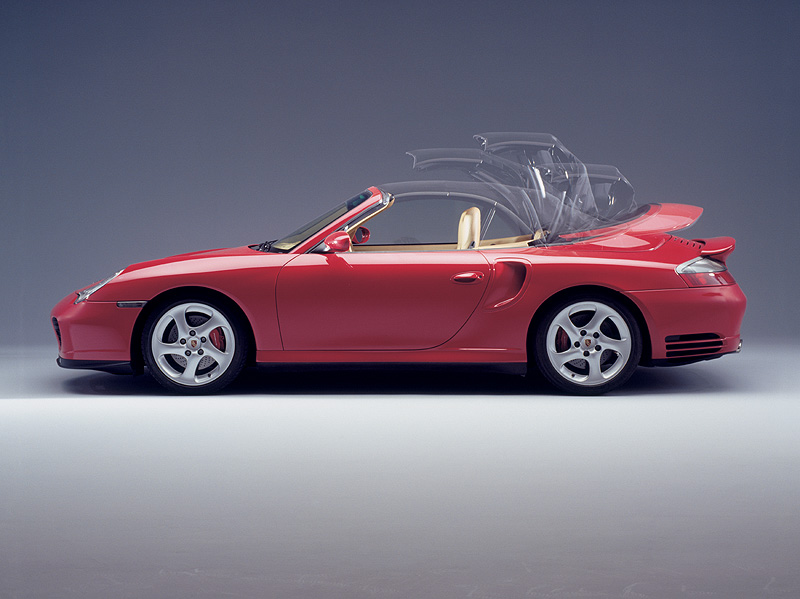
The 2004 Porsche 911 Turbo Coupe and Cabriolet are designed for long-distance comfort as well as high performance, with equipment such as a Bose® digital audio system, leather seating and available features like the Porsche Communication Management system with navigation and a 5.8-inch color monitor.
The 2004 Porsche 911 Turbo Cabriolet comes with a fully automatic three-piece top that opens in a Z-configuration and folds down into a compartment behind the rear seat. Unlike most cabriolet tops that expose the inside of the roof lining when the top is retracted, Porsche’s Z-configuration keeps the inside of the roof protected at all times, takes up less space when the top is stowed, and provides better protection for the heated rear glass window when the top is down.
The Cabriolet top is made of a high-quality fabric, with a special plastic material between the outer and inner layers providing superior sound insulation and heat protection.
A light but stable aluminum frame helps keep the structure stable and resistant to ballooning, even at very high speeds, and applies tension to the section of the roof between the windshield and the first bracket. The top has been tested in a wind tunnel at speeds of nearly 210 mph (338 km/h) without problems.
The roof is fully automatic, operated by a hydraulic system and electric motors that lock the front roof bracket to the windshield frame. A microcomputer masterminds the smooth flow of all functions that opens and closes the top in 20 seconds.
All 2004 Porsche 911 Turbo Cabriolets come with both a standard wind deflector and an aluminum hard top. The wind deflector, made of two frames covered by a net fabric, extends over the area between the front seats and the supplemental safety bar cover and ensures a draft-free driving experience when the top is down. The wind deflector can be installed or removed in a matter of seconds and can be stored in the front luggage compartment.
The aluminum hard top is made from two shells riveted together and includes a parcel shelf that helps reinforce its structure. The hard top has a heated rear glass window, yet weighs only 71 pounds (32 kg), making it easy for a driver and passenger to install when they want the security of a hard roof over their heads.
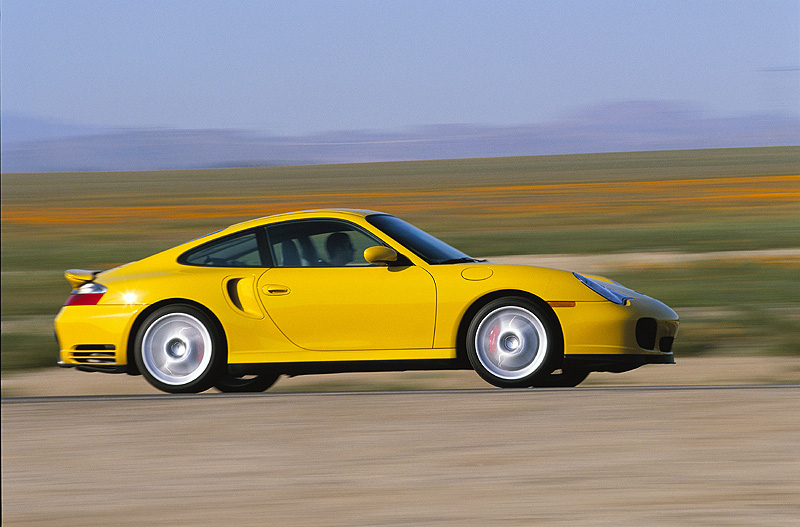
Whether the hardtop is installed or the soft top is up or down, the Porsche 911 Turbo Cabriolet provides outstanding protection for its occupants. The car has two supplemental safety bars that are discreetly hidden behind the rear seats. Should one of the angle sensors detect the imminent risk of the car rolling over, the safety bars automatically deploy.
The 911 Turbo Cabriolet body shell was developed along with the body of the new 911 Carrera 4S Cabriolet and has substantial reinforcements to maintain its safe, stiff structure even without a top. Three-dimensional junction plates are integrated into the side sills and so-called shaft reinforcements, which are welded and bonded, are integrated behind the B-pillars to provide even more strength.
Providing such additional reinforcements was no easy job for Porsche’s development engineers, since the intake openings for the Turbo’s intercooler are located at exactly this point on the sides of the car, and the mechanical and electrical systems for the rear side windows are fitted in this area. To achieve their goals, Porsche’s engineers used high-strength steel.
The 2004 Porsche 911 Turbo Cabriolet is equipped with larger side airbags designed to provide protection for the occupant’s head, chest and hips in the event of a side impact, even when the roof is open and the side windows are lowered.
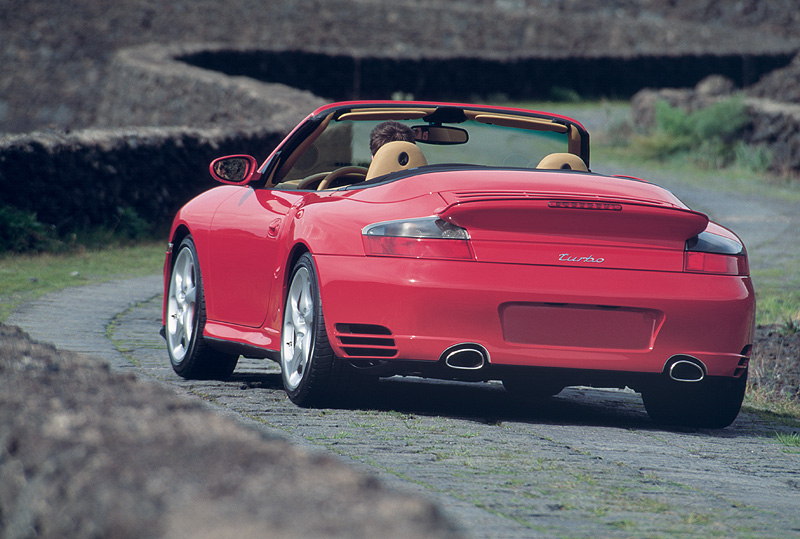
Whether Coupe or Cabriolet, the 2004 Porsche 911 Turbo draws its power and its name from its 3.6-liter horizontally opposed “boxer” engine, which provides 415 horsepower (SAE) and 415 lb.-ft. of torque.
But, for 911 Turbo Coupe drivers who want even more power under their control, an optional factory-installed X50 engine enhancement performance package boosts the turbochargers’ pressure to generate 444 horsepower (SAE) and 457 lb.-ft. of torque.
Porsche began using turbochargers in the famed Porsche 917 racecar in the early 1970s and introduced its first 911 Turbo production model in 1974. The 911 Turbo arrived in the United States for model-year 1976, and with its 234-horsepower (SAE) engine could achieve 0-62 miles per hour (0-100 km/h) in 5.5 seconds.
Porsche also pioneered innovations that increased turbocharging reliability, including the exhaust wastegate to regulate boost pressure and intercoolers to reduce the temperature of the compressed intake air.
Porsche pioneered the all-wheel drive supercar with the limited production 959 of the mid-1980s. Although not imported to North America, the turbocharged 959 became a Porsche legend and paved the way for the first standard-production all-wheel drive Porsche 911 Turbo, which arrived in the United States for 1996.
From the beginning, Porsche designed the 911 Turbo as a fully equipped grand touring car with a high level of standard luxury features.
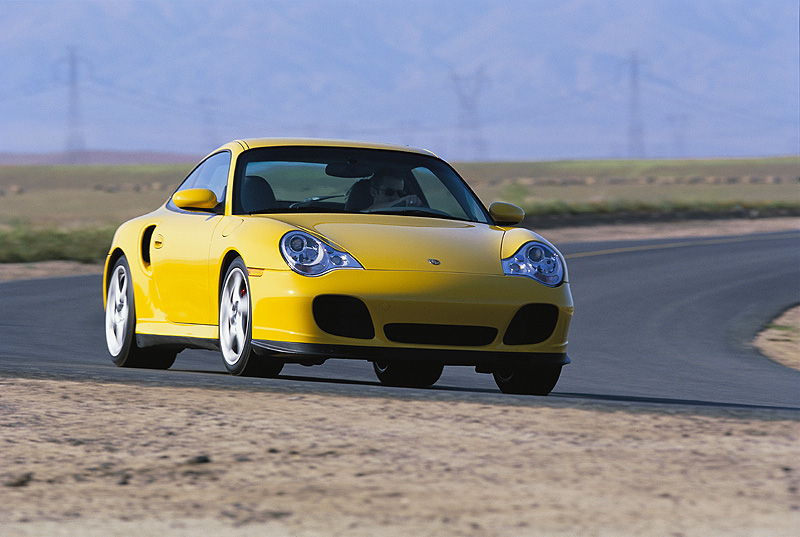
For 2004, the Porsche 911 Turbo is offered in two new colors – Atlas Gray metallic and Carmon Red metallic. It also comes with a special new Turbo tachometer and with two new options: 18-inch SportTechno wheels and 18-inch GT3 wheels.
A racecar-derived 3.6-liter, twin-turbo six-cylinder engine gives the 911 Turbo staggering performance capabilities. The engine produces 415 horsepower (SAE) @ 6,000 rpm and sustains 415 lb.-ft. of peak torque from 2,700 to 4,600 rpm.
Power drives through a standard six-speed manual transmission, with the advanced Tiptronic® S five-speed automatic transmission as an option.
With power characteristics of a far larger engine, the 911 Turbo Coupe can accelerate from 0 to 62 mph (0 to 100 km/h) in just 4.2 seconds. On the test track, the 911 Turbo sprints from a standstill to 99 mph (160 km/h) in only 9.3 seconds and can achieve a top track speed of 189 mph (305 km/h).
Performance times for the Cabriolet are 4.3 seconds for the 0 to 62 mph sprint, 9.5 seconds for the run up to 99 mph and a top test-track speed of 189 mph (with the top up).
The 911 Turbo engine is based directly on the 3.6-liter engine from the GT1 racecar that won the 24 Hours of Le Mans in 1998. (The engine is not a turbocharged version of the 3.6-liter unit used in the 2004 911 Carrera models.) To accommodate the high boost pressure produced by its dual turbochargers, the engine features a 9.4-to-1-compression ratio, compared to 11.3-to-1 for the 911 Carrera models.
Intake air enters through louvers in the engine lid, flows into a joint air filter housing and then into the turbochargers. The turbos compress the air to a maximum of 11.76 psi (0.8 bar over atmosphere). From the turbos, the intake air flows through dual intercoolers (one mounted in each rear fender) and then into the induction system.
Like all current Porsche engines, the 911 Turbo features double overhead camshafts and four valves per cylinder. The new-generation 911 Turbo introduced a new version of the Porsche VarioCam® valve timing system. Called VarioCam Plus, the new system provides continuously adjustable intake valve timing. The system helps boost low-end and mid-range torque. Dual valve springs ensure reliable, high-performance operation.
Sequential multi-port fuel injection features separate fuel mixture control for each cylinder bank, and a coil-on-plug (“distributorless”) ignition system provides quick response and reliable operation. The ME 7.8 engine control module incorporates the E-Gas electronic throttle. In place of a conventional throttle cable setup, E-Gas electronically transmits pedal position to the engine control unit. The new system provides even sharper throttle response and ensures low emissions.
The 911 Turbo also offers an optional X50 engine enhancement performance package that increases horsepower to 444 (SAE) @ 5,700 rpm and sustains 457 lb.-ft of peak torque from 3,500 to 4,500 rpm. The new package includes modifications to the turbocharger, air intake cooler, electronic control unit, exhaust system, as well as a strengthened transmission. The X50 package is only available as an option from the Porsche factory.
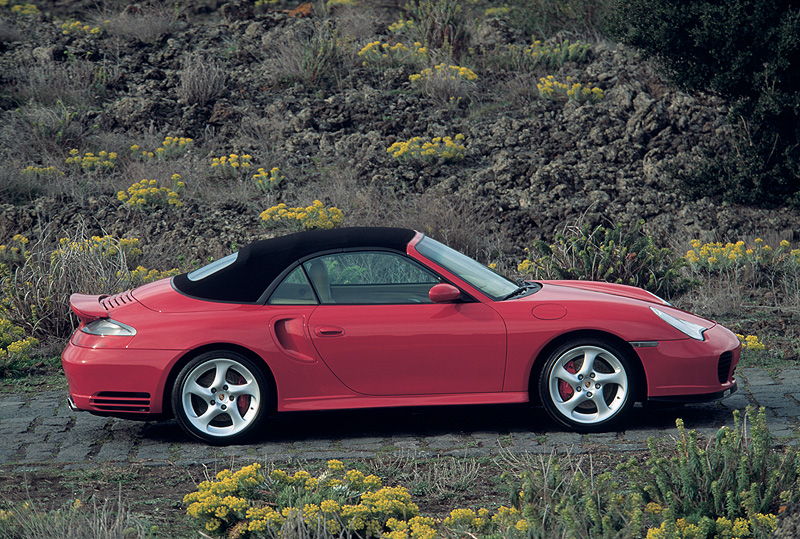
The 911 Turbo offers a choice between a precise-shifting standard six-speed manual transmission and the optional Tiptronic S five-speed automatic transmission. The six-speed manual features a dual-mass flywheel for low vibration and a hydraulic clutch for consistent performance.
With the advanced Tiptronic S, the driver can place the shift lever into “D”, or Drive, and let the transmission do the shifting, or shift into “M”, Manual, and control gearshifts with steering wheel-mounted thumb switches.
In automatic mode, Tiptronic S uses infinitely variable shift points to respond to the driving circumstances and the driving style. During leisurely driving, Tiptronic S up shifts early to provide a quiet ride and the best fuel efficiency. With quicker gas pedal action, the transmission responds by raising shift points to hold each gear longer for crisp response and power. The Tiptronic S transmission draws from among 250 different shift maps to provide optimal performance.
Even while in automatic mode, the computer-controlled Tiptronic S responds like a driver working a manual transmission, downshifting or holding lower gears when cornering and driving on hills. Tiptronic S allows the driver to select manual mode by pressing an up- or downshift button, even with the shift lever in the “D” position.
The 911 Turbo uses an all-wheel drive system based on a viscous multi-plate clutch located directly behind the front differential. Weighing only 120 pounds (54 kg), the all-wheel drive system in the 911 Turbo qualifies as one of the lightest such systems in the industry.
The all-wheel drive system directs torque to the front wheels at a rate of five to 40 percent, depending on available traction and power applied. The viscous unit compensates for differing wheel speeds during cornering.
The 911 Turbo exhibits outstanding traction on all road surfaces. However, Porsche did not originally intend the all-wheel drive system as an all-weather traction assistant.
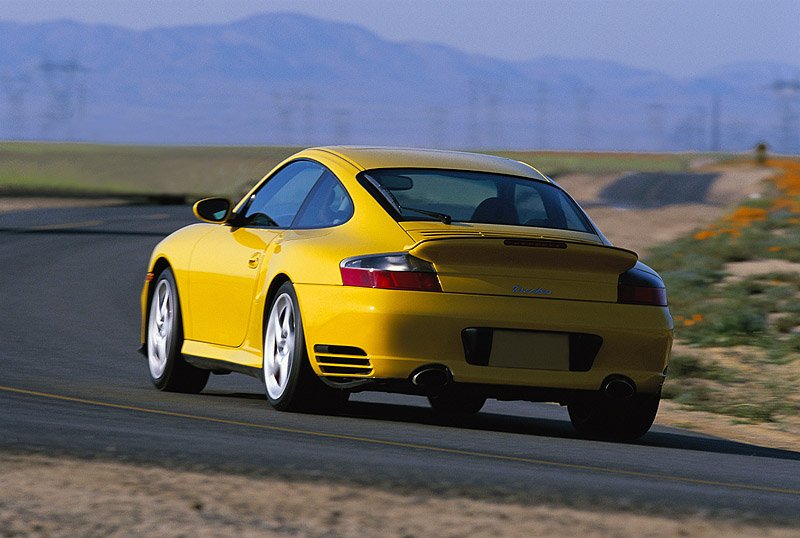
Porsche equips the 2004 911 Turbo with the Porsche Stability Management system (PSM), an innovation the automaker first introduced on the 1999 911 Carrera 4. Using data from several sensor inputs, PSM can detect a loss of grip at the front or rear and reduce instability by applying braking to individual wheels and, if necessary, altering engine power. PSM can help keep the 911 Turbo going in the direction the driver steers, especially on slippery roads.
The PSM system operates so quickly that most drivers likely will not feel it making corrections, and, if activated, the system operates whether or not the driver is using the brakes. The driver can disengage PSM with a dashboard switch, but, for safety, PSM will engage under braking and then disengage when the driver lifts off the brake.
While the system provides dynamic handling assistance, Porsche cautions drivers that PSM cannot counteract the laws of physics.
The four-wheel independent suspension features a Porsche-optimized MacPherson-strut design in front and a multilink setup in the rear, both with aluminum suspension components to reduce unsprung weight. Front and rear stabilizer bars and gas-charged shock absorbers provide flatter cornering. Standard power rack-and pinion steering yields a quick 2.98 turns lock-to-lock and a tight 34.8-ft. (10.6-meter) turning circle.
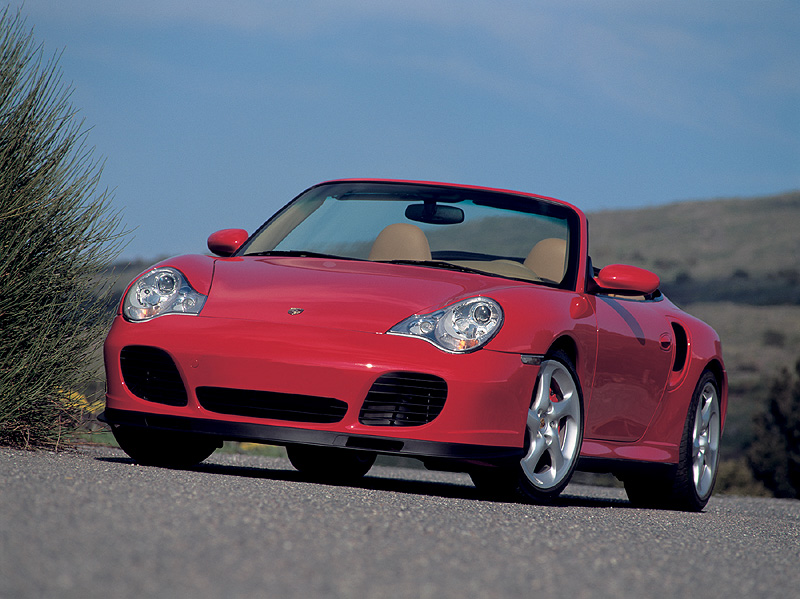
A “staggered” wheel/tire array (wider wheels and wider, lower-profile tires in the rear) contributes to neutral handling. The standard aluminum hollow-spoke alloy wheels measure 8 x 18 inches in front and mount 225/40 ZR18 tires; the 11 x 18-inch rear wheels mount 295/30 ZR18 tires
The 2004 Porsche 911 Turbo employs the four-wheel vented disc brakes derived from the Porsche GT1 racecar. One-piece (“monoblock”), four-piston brake calipers reduce unsprung weight and improve heat dissipation. The front and rear discs measure 13 inches in diameter (330 mm), but differ in thickness – 1.34-inches (34 mm) in front and 1.1-inches (28 mm) in the rear. The cross-drilled discs dissipate heat to maintain braking performance and brake feel even under hard usage.
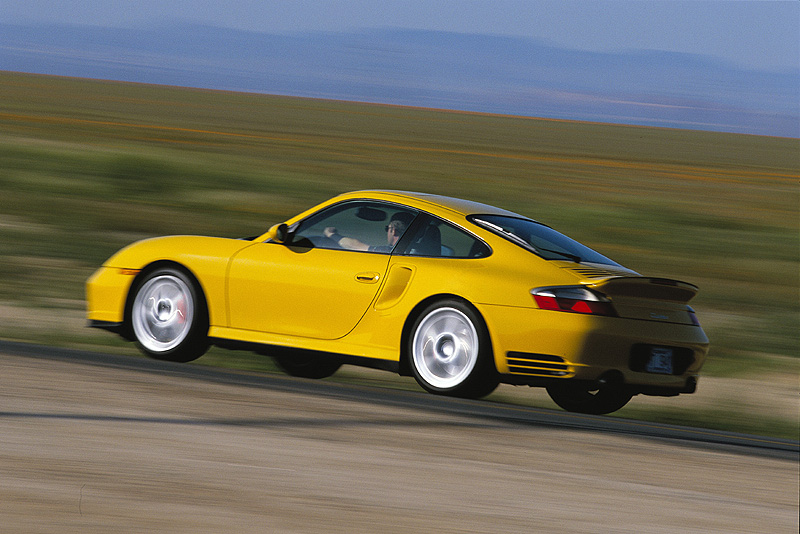
With the high performance potential of the 911 Turbo comes a high level of occupant protection. A patented crumple zone body structure helps to protect a reinforced passenger compartment. Supplementing the three-point inertia-reel seatbelts, the 911 Turbo has seatbelt pretensioners and load limiters.
All 2004 Porsche models include dual front airbags plus the Porsche Side Impact Protection System that includes boron-steel door reinforcement beams, energy-absorbing door panels, and door-mounted side airbags. The 30-liter capacity side bags provide additional protection for the chest, head, and pelvis.
At a customer’s request, an authorized U.S. Porsche dealer can install a system that deactivates the passenger airbags when a U.S. Porsche-approved child seat is used. The system features a cross brace with belt lock in front of the passenger seat. Buckling the special child seat into this brace deactivates the airbags. To activate the system, the dealer also must reprogram the airbag control module.
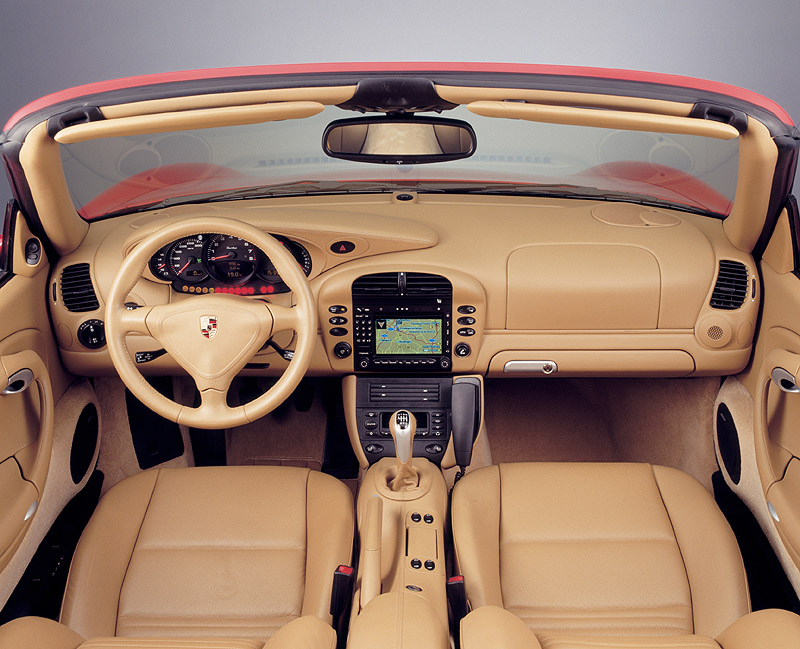
While the 911 Turbo inspired the most recent front-end redesign of the 911 Carrera models, the Turbo retains many exclusive body parts and design elements. Three large intake grills dominate the lower front fascia and provide cooling air to the car’s three radiators.
Compared to the 911 Carrera models, the 911 Turbo has a wider stance, particularly at the rear, where the 911 Turbo is 2.36 inches (60 mm) wider to accommodate the standard 18-inch alloy wheels and massive 295/30 ZR18 tires.
Air scoops integrated into the leading edges of the rear fenders channel air to the turbocharger intercoolers, while louvers in the sides of the lower rear cover exit air from the intercoolers. The engine compartment lid carries a two-piece rear stabilizer wing, the upper part of which automatically rises at speeds of more than 75 mph (120 km/h) and lowers at 50 mph (80 km/h).
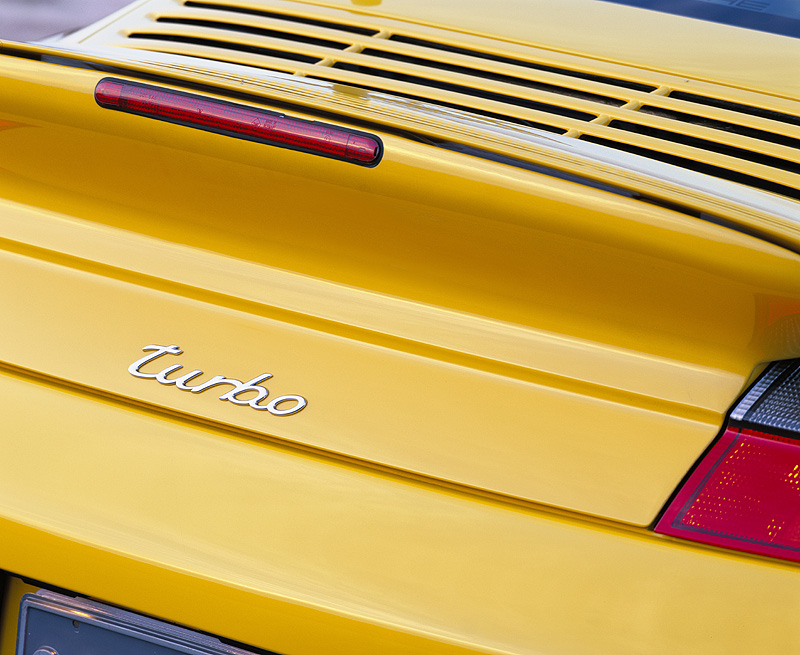
The 911 Turbo comes equipped with a full slate of standard luxury and security features:
The remote entry system allows the driver to open the luggage compartment lid and operate the seat memory function.
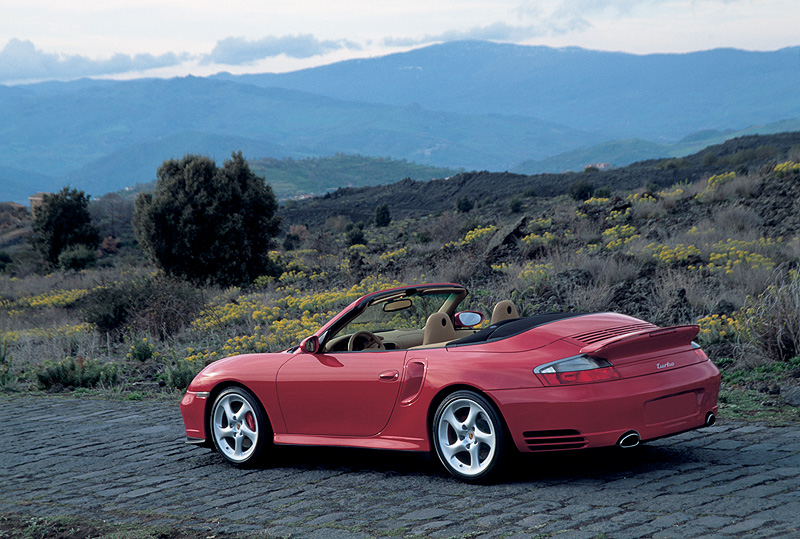
Porsche’s new Communication Management system (PCM®) comprises tuners, CD player, navigation system, and trip computer, all linked through Media-Oriented Systems Transport (MOST) digital data bus. The MOST system incorporates light-wave conductors that exchange data between the individual components without loss of quality and at ultra-high speeds.
PCM includes a 5.8-inch (147 mm) color screen with its 16:9 aspect ratio and 12-position keyboard for easily and efficiently entering radio frequencies. The system ensures excellent audio quality. The navigation module provides such features as road junction zoom-in, dynamic navigation to avoid congestion, map scrolling so you can see beyond your current position, tour planning with the ability to memorize as many as eight destinations in a row and a CD-ROM system that can be used for the navigation system or for music.
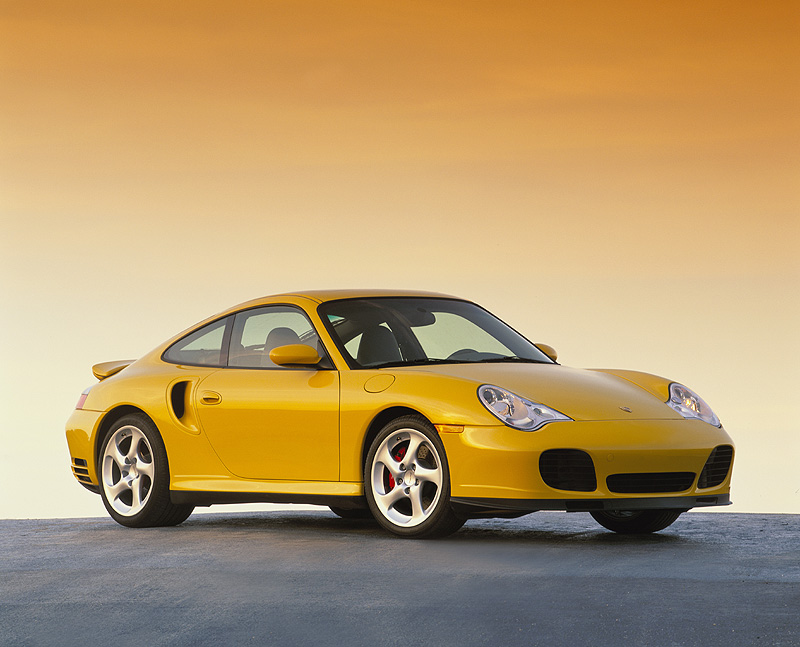
The 911 Turbo features the Bose system as standard equipment, while other Porsche models offer a Bose system as an option. Each Bose audio system has been custom-engineered for a particular Porsche model. The Bose automotive music systems combine balanced stereo, a panoramic soundstage, deep bass and smooth frequency response to produce lifelike music reproduction even in the challenging environment of a car. Digital amplifiers provide clean, uncolored sound at any listening level. In the 911 Turbo, 12 advanced loudspeakers (11 in the Cabriolet) and a subwoofer blend seamlessly into cabin trim, raising and widening the sound stage and ensuring balanced stereo.
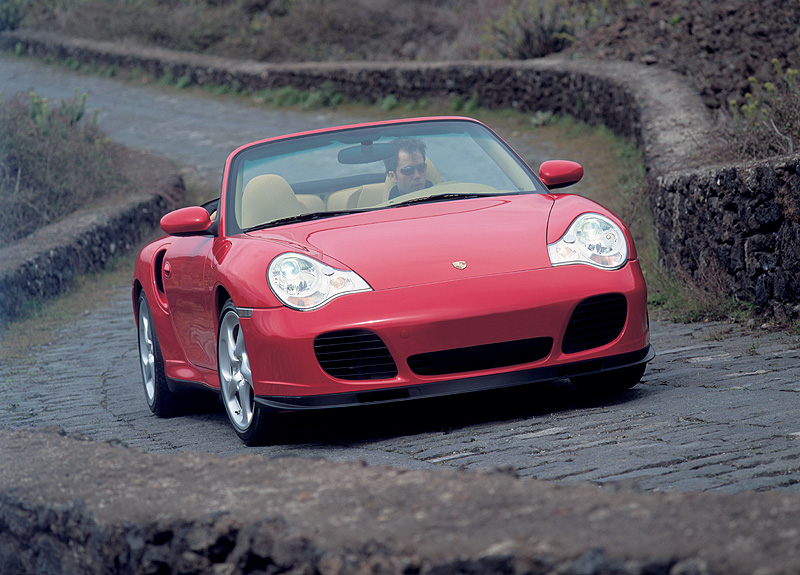
Porsche Cars North America offers customers in the United States and Canada the opportunity to personalize their cars through two option-selection channels. Together with the choice of limited-availability special paint colors, the special options allow a customer to make a Porsche into a truly one-of-a-kind car. The Porsche Exclusive program offers a wide array of optional features installed at the factory. Options include custom interior trim packages and individual trim items.
The Porsche four-year/50,000 mile bumper-to-bumper warranty covers all Exclusive options, and Porsche dealers can include the cost of the options in the lease or finance contract.
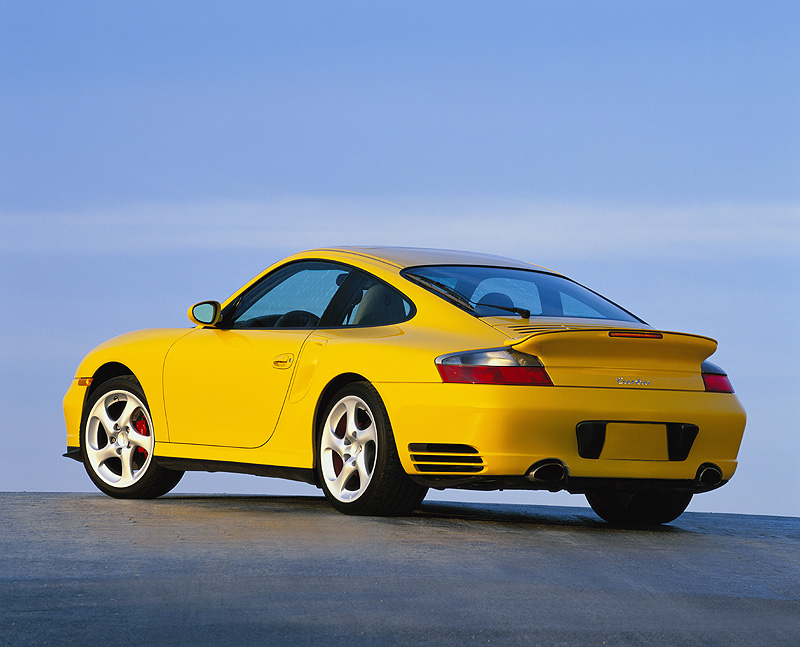
The Tequipment (“Tech-quipment”) program offers a line of accessories available only from authorized Porsche dealers. Tequipment options include such items as special wheels, an aerobody kit, instrument panel trim kits, CD changers, and custom floor mats. Customers can order Tequipment options at the time of purchase or return to the dealership for installation later. While installation of Tequipment may require some modifications to the car, such modifications do not affect the standard limited warranty. Tequipment items come with a two-year warranty when installed by a certified technician at an authorized Porsche dealership.
In addition to the limited-availability special paint colors, Porsche will even paint a 911 Turbo to match a sample from the customer. The Porsche 26-step corrosion protection and paint process ensures that the custom paintwork meets the same quality standards as a regular production paint color. The Porsche three-year/unlimited mileage paint finish and 10-year/unlimited mileage corrosion perforation warranties apply to any custom color.
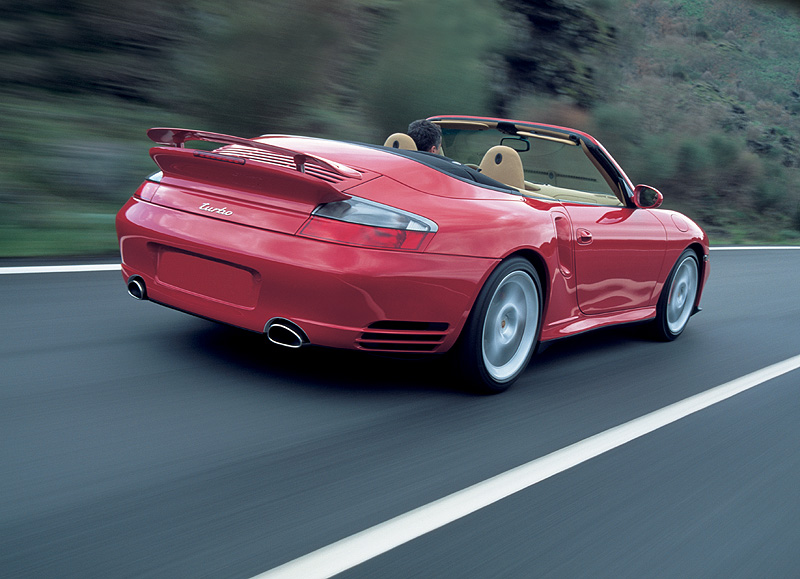
Every new model-year 2004 Porsche car sold in the United States and Canada is covered by a four-year/50,000-mile (80,000 kilometer), bumper-to-bumper limited warranty, which includes Porsche’s roadside assistance program. The galvanized body and 26-step paint and anti-corrosion process enable Porsche to warranty each car against rust perforation for 10 years and unlimited mileage. In addition, Porsche guarantees the paint finish for three years – also without a mileage limitation.
Porsche Cars North America, Inc. (PCNA), based in Atlanta, Ga., and its subsidiary, Porsche Cars Canada, Ltd., are the exclusive importers of Porsche vehicles for the United States and Canada. A wholly owned, indirect subsidiary of Dr. Ing. h.c.F. Porsche AG, PCNA employs approximately 250 people who provide Porsche vehicles, parts, service, marketing and training for its 204 U.S. and Canadian dealers. They, in turn, provide Porsche owners with best-in-class service.
.jpg)
.jpg)
.jpg)
1995 - 993 Turbo
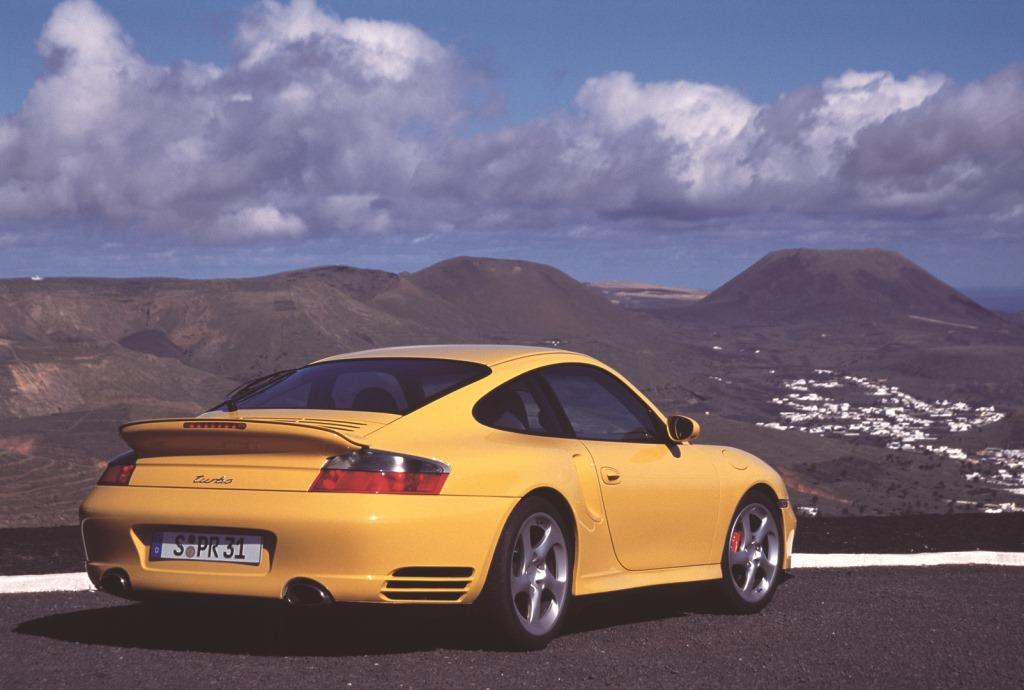
2002 Porsche 911 Turbo

Porsche Press kit

Porsche Literature

Our Porsche Cars